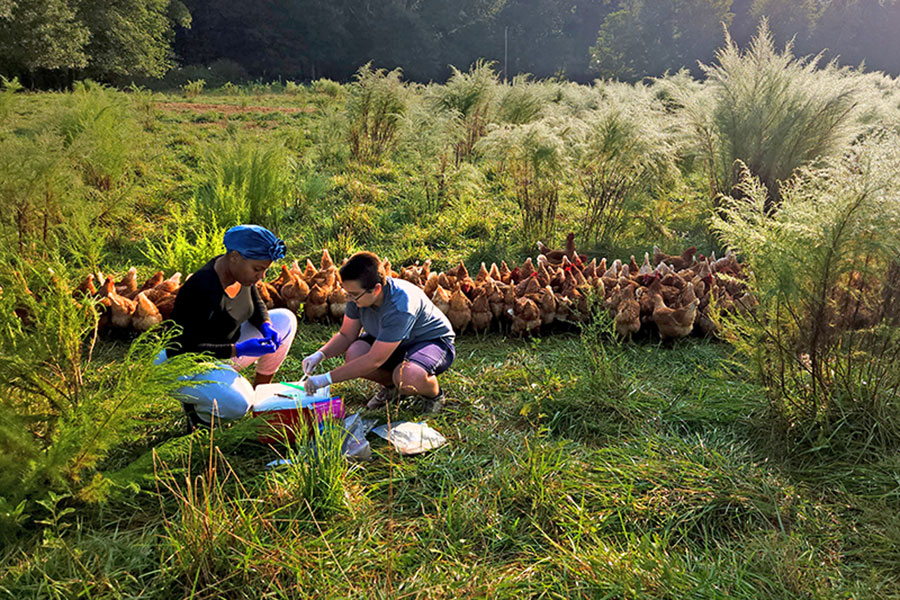Eggs from Wright County Egg of Galt, Iowa, have been recalled. The number of recalled eggs soared to 32 million cartons for a total of 380 million eggs on Aug. 19. According to the expanded recall, potentially contaminated eggs could have been sold in Georgia stores.
Hundreds of consumers have been sickened by the Salmonella-contaminated eggs. Officials worry that number could reach into the thousands. While some of the contaminated eggs may have been sold in Georgia, it is unlikely an infected egg would be produced in Georgia.
“The Georgia egg industry does an excellent job preventing Salmonella enteritidis from contaminating table eggs produced in this state,” said Scott Russell, a poultry scientist with the University of Georgia College of Agricultural and Environmental Sciences.
Georgia producers pull egg-laying hens from Salmonella-free flocks. Salmonella reaches the egg if the flock of hens harbors the bacteria and then passes the bacteria through their ovaries into the eggs.
The U.S. Food and Drug Administration recently released a new law regarding Salmonella enteritidis in table eggs. Georgia egg producers are complying with the “Final Rule for Prevention of Salmonella Enteritidis in Shell Eggs during Production, Storage and Transportation.”
The law requires that white leghorn laying hen chicks be tested for Salmonella enteritidis soon after they hatch. Then, the flock is tested prior to production at 14 to 16 weeks of age and then again after 45 weeks of age.
“If any of these samples come back positive for Salmonella enteritidis, then 1,000 eggs must be pooled and tested every two weeks for an eight-week period for a total of 4,000 eggs,” Russell explained. “If any of these samples are positive, then the product must be diverted to a stream that will be cooked or pasteurized.”
Consumer tips
Salmonella is a common bacterial form of foodborne illness. And the strain involved in the outbreak is the most common strain of Salmonella, accounting for 20 percent of all Salmonella foodborne illnesses.
Salmonella is an organism that can cause serious and sometimes fatal infections in young children, frail or elderly people and others with weakened immune systems. Healthy people infected with salmonella often experience fever, diarrhea, nausea, vomiting and abdominal pain. In rare cases, infection with Salmonella can result in the organism getting into the bloodstream and producing more severe illnesses such as arterial infections, endocarditis or arthritis.
Most Salmonella cases are linked to raw or undercooked egg products, like salad dressings and meringue toppings.
“We have known for years there is a possibility that eggs could contain Salmonella,” said Judy Harrison, a food safety expert with UGA Cooperative Extension. “We advise consumers to cook eggs thoroughly to destroy Salmonella.”
Casseroles containing eggs and quiches should be cooked until the internal temperature reaches 165 degrees Fahrenheit. Scrambled eggs should be cooked until no liquid egg is visible. Eggs with a runny center should be avoided.
Pasteurized egg products are safe to use in recipes that call for uncooked eggs. The pasteurization process heats the eggs to a temperature that would kill any bacteria present. All pasteurized egg products are clearly labeled.
“Although thoroughly cooking eggs destroys all Salmonella bacteria, the FDA is advising consumers that all recalled potentially contaminated eggs be discarded or returned to the store for a refund,” Harrison said.
The Center for Disease Control offers the following tips for egg safety:
- Eggs should be kept refrigerated at 40 degrees F.
- Discard cracked or dirty eggs.
- Wash hands, cooking utensils and food preparation surfaces with soap and water after being in contact with raw eggs.
- Do not keep eggs warm or at room temperature for more than two hours.
Recall
The 380 million eggs being recalled are packaged under the following brand names: Albertsons, Farm Fresh, James Farms, Glenview, Mountain Dairy, Ralphs, Boomsma, Lund, Kemps and Pacific Coast. Eggs are packed in varying sizes of cartons (6-egg cartons, dozen egg cartons, 18-egg cartons and loose eggs for institutional use and repackaging) with Julian dates ranging from 136 to 229 and plant numbers 1720 and 1942.
Dates and codes can be found stamped on the end of the egg carton or printed on the case label. The plant number begins with the letter P and then the number. The Julian date follows the plant number, for example: P-1720 223.
To learn more about the recalled products, visit the United Egg Producers Egg Safety Center product recall site at www.eggsafety.org/mediacenter/alerts/73-recall-affected-brands-and-descriptions.








